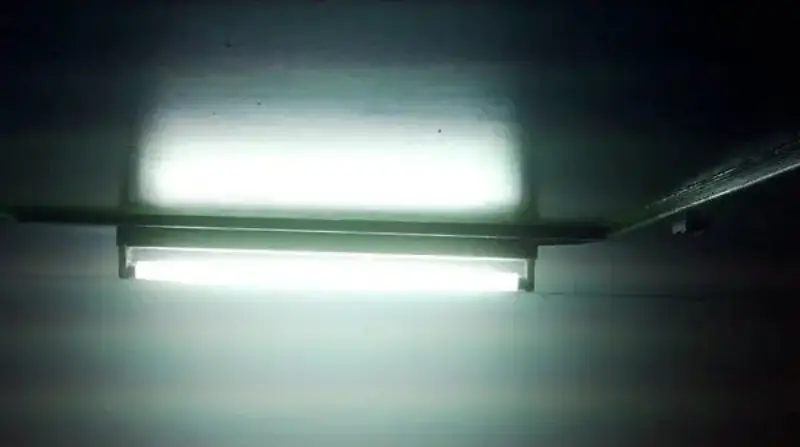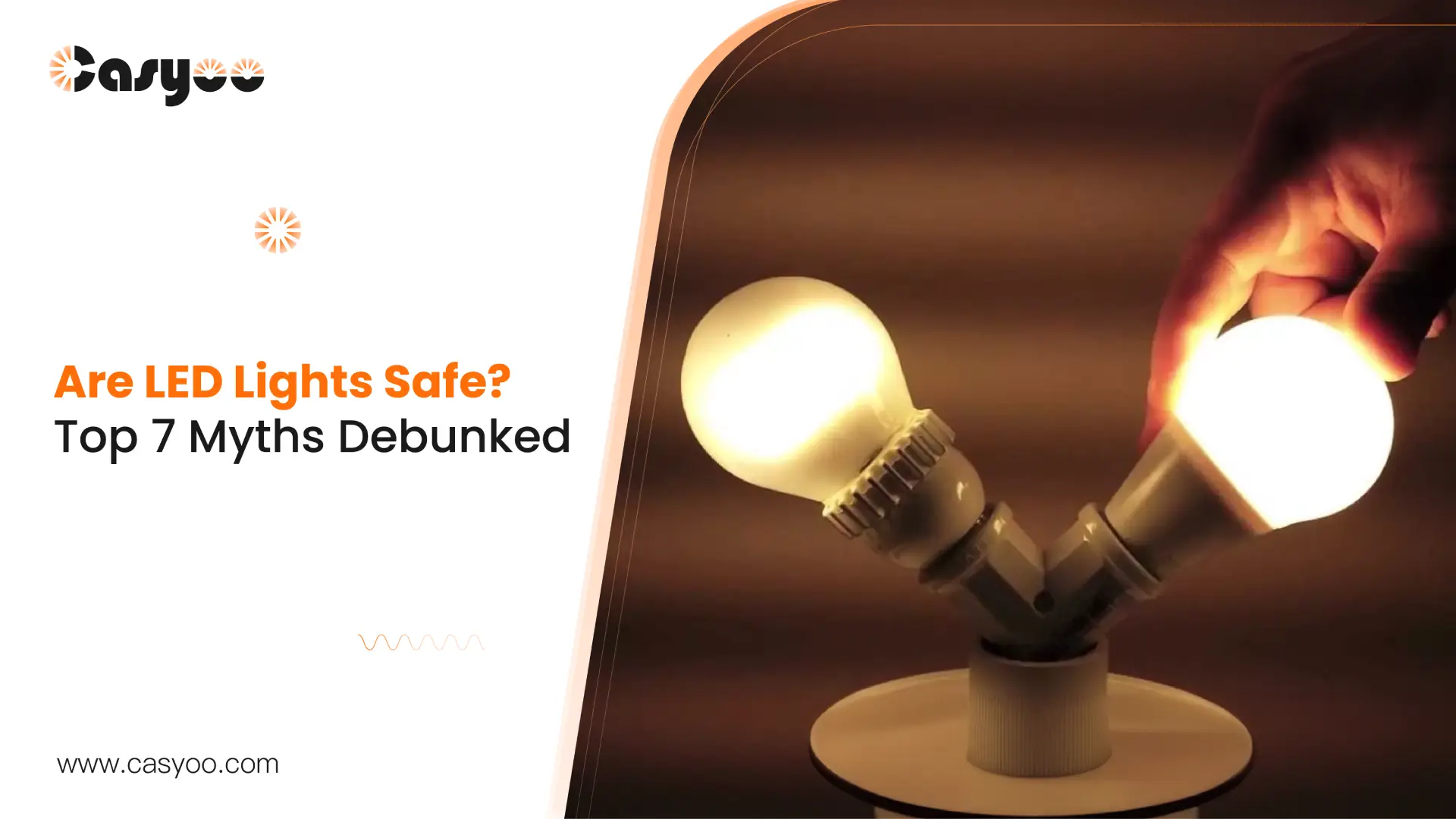LED lights have gradually become the mainstream lighting fixtures for home lighting, and people have begun to pay attention to the safety issues of LED lights. Will LED lights become as hot as incandescent and fluorescent lights if used for a long time? Is the blue light of LED lights harmful to our eyes? There are also some opinions that doubt whether LED lights will affect sleep, cause headaches, and have adverse effects on our skin. Are LED lights safe? Read this passage where we discuss the 7 most popular myths about LED lights, and find out what kind of LED lights are the safest.
Myth 1. It is not safe to leave LED lights on.
For LED lights, the most common questions users have are how long they can keep LED lights on, whether they can use the lights all night, and whether they will overheat. These are all about the heat emission of LED lights. LED lights have very good photoelectric conversion efficiency, and can convert a large part of electrical energy into light energy. At the same time, they will only convert a small part of energy into heat, so the lamp won’t get very hot like traditional lights. Their high efficiency also keeps the load on the power supply line low, ensuring the safety of the line.
In other words, LED lights are the most suitable choice for long-term continuous lighting. It is okay to turn on the lights all night in daily use, and good-quality LED lights can also be left on 24/7, as long as the surrounding environment is not too hot or humid.
But of course, LED lamps do generate a little heat when they are working. Additionally, the control circuit will produce some heat. The temperature of the lamp will gradually increase if they work for a long time. Therefore, checking if the LED lamp is overheating every once in a while is still important. If you have seen news about an accident where LED lamps overheated and caught fire, it is very likely that the LED lamps they used did not meet the heat dissipation standards. Qualified LED lamp components should have sufficient heat resistance. In addition, it is also possible that they did not install the LED lights correctly, such as using the lights in a humid place or leaving no heat dissipation space for the LED lights.
Myth 2. The blue light emitted by LED lights will hurt our eyes.
According to the standard IEC62471 “Photobiological Safety of Lamps and Lamp Systems,” 400nm~500nm blue light may cause retinal disease. However, blue light actually exists everywhere in our lives. Many conventional lighting fixtures, such as metal halide lights seen in stadiums and retail centers, not only emit blue light but also UV and infrared radiation that can cause eye diseases. Blue light is a necessary component for generating white light, so it exists in all lighting products.
People think LED lights emit too much blue light because some of them generate white light by using blue light and yellow phosphor. However, LED lamps have taken many measures to control the blue light generated. First, IEC62471 has stipulated the limit of radiance or irradiance of blue light from lamps. As long as the LED lights meet the corresponding blue light standard, they have no photobiological hazards. Second, there are also LED lights that create white light with RGB light, which lowers the portion of blue light. In addition, if you worry about the harm of blue light, you can choose warm white LED lamps with low color temperature.
Myth 3. LED lights are bad for our sleep.
LED lights are said to violate our sleep because of the blue light. Long-term exposure to blue light will send a signal to the brain to reduce the secretion of melatonin. Lacking melatonin can disrupt the circadian rhythm of the human body, causing insomnia. However, in general, LED lamps used as night lights are designed with low color temperature, low brightness, and low blue light in order not to affect sleep. Many LED lights are dimmable and have adjustable color temperatures. When adjusted to 3000-3500K warm white light, less blue light is emitted. What’s more, some lights have lampshades to filter out blue light. Therefore, choosing LED lights correctly can greatly reduce the impact of blue light on sleep.
Myth 4. LED lights will flicker, causing headaches.
A flickering lamp is indeed harmful to the human body and should be replaced immediately. But flickering is not a problem that only LED lights have. Other light sources may also flicker, and it all depends on the quality of the lamps. Besides, as the latest lighting technology, LED lights have developed a variety of ways to control flicker. For example, qualified LED bulbs are equipped with constant current chips inside, which can effectively reduce flicker. In addition, there are a variety of methods to rectify LED circuits. As long as you buy a qualified LED lamp, there will be almost no flicker problem. It is also quite easy to tell whether the lamp flickers. Simply open your phone’s camera and point it at the lamp. If there are frequently fluctuating lines on the screen, it means the lamp is flickering.

Myth 5. LED lights have adverse effects on our skin.
Some people see LED lights being used as tanning lights and start to wonder if long-term use of household LED lights will also have an impact on the skin. If you think so, you should distinguish between LED beauty lights and regular LED lights. The wavelength of light from regular LED lamps is a larger range, while medical LED bulbs accurately control the wavelength of light to a certain more precise range. For example, 415nm blue light is most effective in treating acne, so medical blue light will control the wavelength within the range of 415±5nm. Regular LED lights have a large wavelength range, and the proportion of light in each band is very small, so it will not affect our skin.
Myth 6. The metals in LED lights are harmful.
Mercury is extremely harmful to both the environment and human health and can be found in common fluorescent lamps, high-pressure mercury lamps, etc. However, it does not exist in LED lights, which makes LED lights safer than others. Furthermore, LED lights are also free of dangerous elements like lead and cadmium that are present in some other conventional lights. LED lights do contain nickel and copper, but these elements are widely used in daily consumer products. For example, the internal conductive wires of fluorescent lamps are mostly nickel-plated iron. Many traditional lamps use copper-plated iron wires, nickel-plated copper wires, etc., and most of the E27 and E14 lamp holders of fluorescent lamps are also made of iron-plated nickel. Compared with these lights, the metal elements in LED lamps have little influence.
Myth 7. LED lights emit eMF, which is harmful to us.
LED lamps often use PWM technology to achieve constant current power supply and dimming functions, so a certain degree of electromagnetic harmonics will be generated. However, the electromagnetic field generated by LED lamps belongs to “low-level electromagnetic field”. There is no evidence that low electromagnetic radiation in life will affect people’s health. Moreover, the magnetic field level drops sharply with distance, and the impact turns very small.
What are the safest LED lights?
- Choose LED lamps produced by reliable manufacturers, which should pass various tests and certifications, such as UL, RoHS, etc.
- The shell of the lamp should use flame-retardant plastics. Ordinary plastics are easy to deform and flammable, and are prohibited to produce lamps. One may clearly tell between these two types of plastics by their surface: the former has a texture that is comparable to frosted glass, while the latter has a surface that is smoother and glossier.
- Aluminum and iron heat sinks are preferred over plastic materials. The larger the substrate area, the better the heat dissipation effect.
- The temperature rise of LED lamps should be very low under normal working conditions. At the same time, check to see if the LED lamp flickers.
- The LED lamps should use a constant-current driving circuit.
- To prevent the potential negative health effects of blue light, indoor LED lights should have a color temperature of no more than 4000K, and the CRI should be at least 80.
- To prevent the impact of glare on the eyes, the URG of LED lamps should be about 16-19 for daily use.
Conclusion
LED lamps are not as harmful as mentioned in the myths. In terms of heat dissipation and blue light, as long as you can buy qualified LED lamps, there will not be too many safety hazards. This article also mentions other aspects of LED safety and gives suggestions for purchasing LED lamps. Explore Casyoo for LED lights that boast a variety of certifications, such as CE and UL, and have successfully passed rigorous safety tests. With 17 years of experience in LED lighting production, we are dedicated to ensuring the safety and satisfaction of our customers. Contact our experts right away!




